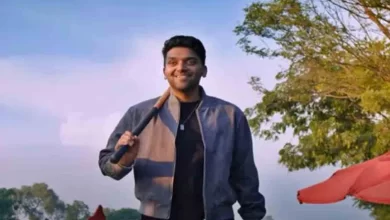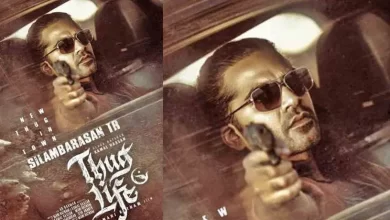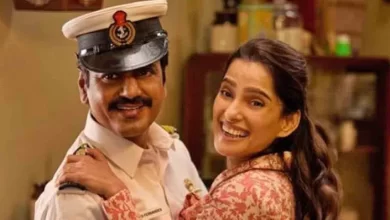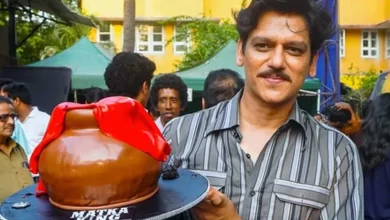Shailendra; the brightest star of Hindi cinema’s Golden Era

- Kisi ki muskurahaton pe ho nisaar, kisi ka dard mil sake to le udhaar, kisi ke vaaste ho tere dil mein pyar, jeena isi ka naam hai.
“Bhagat Singh is baar na lena kaya Bharatwasi ki,
Desh Bhakti ki aaj bhi sazaa hai phansi ki.”
This is the renowned Hindi poet, turned Hindi film lyricist Shailendra, whose simple, yet powerful, words still seem to resonate with the masses.
He started his career by writing fiery poetry for the Indian People’s Theatre Association (IPTA). He wrote, Ke buri hai aag pet ki, Bure hain dil ke daagh yeh, Na dab sakenge, Ek din banenge inquilaab yeh. (The hunger in the stomach is bad, and the wounds of the heart are bad. They will not be silenced. They’ll bring revolution one day.)
His Zor-zulm ki takkar mein Hartal humara naara hai (Protest is our slogan to fight against injustice) became a slogan for rallying workers for their rights. All this was while he was working as a welder in the Railways in Mumbai.
The greatest showman of our times, Raj Kapoor, discovered Shailendra and introduced him to Hindi cinema. And Shailendra went on to become the brightest star of the Golden Era of Hindi cinema.
Just as a writer is known for his works, a lyricist is known for his songs. Shailendra will be remembered for his evergreen songs, which continue to haunt the people.
Shailendra greatly impacted Hindi cinema, taking its lyrics to another level. His simple, direct, flowing poetry touched the hearts of audiences across the social strata.
As we step into Shailendra’s Birth Centenary year on August 30, 2022, which culminates on August 30, 2023, it is time to recall the genius. But he did not get the recognition that he so richly deserves.
Chaste Hindustani
At a time when high-flown Urdu poetry dominated the Hindi cinema, led by the likes of Sahir Ludhianvi, Shakeel Badayuni, Kaifi Azmi and Majrooh Sultanpuri, that was the time when Shailendra brought in commonplace Hindi that people could easily understand and could connect with.
A great Hindi poet, he wrote in Chaste Hindustani, which is so different from the highly Sanskritised Hindi of today.
This trend of highly Sanskritised Hindi became more pronounced since the partition. With a communal venom, deliberate efforts were made to keep out any word even remotely connected to Urdu.
When the National Official Language was decided upon soon after Indian Independence on August 15, 1947, Mahatma Gandhi and Pandit Jawaharlal Nehru were in favour of the adoption of Hindustani, a mix of Hindi and Urdu.
That was the official policy of Congress during the Freedom Struggle. That was the language of Bhagat Singh, who gave the slogan, Inquilaab Zindabad, and of Netaji Subhash Chandra Bose, who gave us Jai Hind. His INA was Aazaad Hind Fauj and not Swatantra Bharat Sena.
Similarly, Ram Prasad Bismil, who immortalized Sarfaroshi ki tamanna ab humaare dil mein hai, dekh na hai zor kitna baazu-e-qaatil mein hai, and even Munshi Prem Chand, Raghupati Sahay Firaaq Gorakhpuri and, in our own times, Gopi Chand Narang, were the flagbearers of Hindustani.
After Independence, the Congress official line remained unchanged and the same. But this line did not have smooth sailing.
In the Constituent Assembly, there was considerable division over the issue of the official language of India. There was a demand even for making English the lingua-franca, or the link language, of India, especially in the Centre-state and Inter-state communications.
Finally, the choice was between Hindustani and Hindi. During the vote, there was a tie. Constituent Assembly Chairman Dr Rajendra Prasad gave his casting vote in favour of Hindi. This was a line opposed to Hindustani that was favoured by Mahatma Gandhi and Pandit Jawaharlal Nehru.
With the passage of time, and with the Saffron Brigade gradually gaining control over the media, a highly artificial, Sanskritised Hindi, typified by Dharma Yug, came to dominate the public discourse. Obviously, this was unintelligible to the common man.
Charming Language of Shailendra’s songs
At a critical juncture, when India attained Independence in 1947, the 24-year-old Shailendra appeared on the scene in Mumbai. It was there that he went on to unravel the magic of easy-flowing Hindi, which captured the imagination of the people. It is refreshing to recall great Hindi writers, to feel the charm and beauty of the language that seems to be lost nowadays.
Shailendra presents Hindi in a different light than it is known for its heavily Sanskritised Dharma Yug language, which is cut off from social reality.
There is a lyrical charm in his easy-flowing language, which is hard to find among other lyricists. Sample this. In Aashiq, he penned absolutely magical lyrics, Mehtab tera chehra, kis khaab mein dekha tha, aie husn-e-jahaan batla, tu kaun main kaun hun?
Yet another equally magical song in the same film is, Tum jo humaare meet na hote, geet yeh mere geet na hote, hans ke jo tum yeh rang na bharte, khwaab yeh mere khwaab na hote. Another of his famous song, also from the same film, is, Oh shama, mujhe poonkh de, main na main rahun, tu na tu rahe, yehi ishq ka hai dastur.
In hariyali aur raasta is his song, Bol meri taqdeer mein kya hai, mere humsafar ab to bataa, jeevan ke do pehlu hain, Hariyali aur Raasta… Tumhaare khwaab se dil-kash nazara aur kya hoga, ke tum mere sahaare ho, sahara aur kya hoga.
A memorable song in Raat Aur Din, made in 1967, is, Na chhedo kal ke afsaane, karo is raat ki baaten…. Har ek din kal ka jhhagda hai, Har ek din kal ka hai rona, yeh ghadiyan raat ki tum bhi na auron ki tarah khona, jo kal hoga, Khuda jaane, karo is raat ki baaten.
Another, very emotional song from the same film is, Jeena hum ko raas na aayaa, Hum jaane kyon jeete hain. In it, there is a line, Daur-e-Junoon mein kya kya soojhi, kya-kya humne kar dala, khud hi gharebaan phaad liye hai, khud hi gharebaan seete hain.
Strengths of Shailendra
Shailendra could pack optimism in a song like in, Aa ab laut chale, nain bichhaaye, baahen phasare, tujh ko pukaare desh tera in Jis Desh Mein Ganga Behti Hai, made in 1960.
There is ethical strain in Sajan re jhhoot mat bolo, Khuda ke paas jaanaa hai, na haathi hai na ghoda hai, wahaan paidal hi jana hai, in Teesri Kasam, made in 1966.
Nehruvian idealism is reflected in a song like in Boot Polish made in 1954, “Nanhe-munne bachhe teri muthi mein kya hai…. bheekh mein jo moti mile, loge ya na loge, zindgi ke aansuon ka bolo kya karoge, beekh mein jo moti mile to bhi hum na lenge, zindgi ke aansuon ki Mala pehnenge, mushkilon se ladte-bhidte jeene mein mazaa hai….”
Shailendra appears as a wordsmith.
For example, there is a song in Guide, made in 1965, Wahaan kaun hai tera, musafir, jayega kahaan, in which there is a line, Kehte hain gyaani, duniya hai phaani, pani pe likhaai, hai sab ki dekhi, hai sab ki jaani, haath kisi ke na aani.
In the same song, there is a magical line, Tune to sab ko raah bataai, tu apni manzil kyon bhula, suljhaa ke raaja auron ki uljhan, kyon kachche dhaagon men jhula, kyon naache sapera musaafir.
In the phrase, Kyon naache sapera, reference is why a sapera, who makes others dance to his tunes, has, himself, ended up dancing. It is a phrase that conveys the essence of the cinematic situation.
Shailendra had a flair for writing songs full of pathos. One example is Aamrapali, made in 1966, where he wrote lyrics for two songs, Tumhe yaad karte-karte, jaayegi rain saree and Tadap yeh din-raat ki.
He did a flamboyant song, like the title-song in Around the World. Shailendra literally conducts a world tour, through Los Angeles, Miami, Washington, New York, London, Paris, Berlin and Venice. He has a message for humanity, Hum Aman chaahne waale, hum pyaar pe marne waale, ek baat kahenge sab se, nafrat ko mita do jag se.
Lyrical beauty of Shailendra’s songs
There is lyricism in his songs. This is seen in his song in Kanhaiya, made in 1959, Mujhe tum se kuch bhi na chaahiye, mujhe mere haal pe chhod do, mera dil agar koyee dil nahi, use mere saamne tod do and Yaad aayee aadhi raat ko kal raat ki tauba, dil poochhta hai jhoom ke, kis baat ki tauba.
In Dil Apna Aur Preet Parai, made in 1960, Shailendra had penned the title-song, Dil apna aur preet parai, kis ne hai yeh reet banai and Ajeeb dastaan hai yeh, kahaan shuru kahaan qatam.
In Asli-Naqli, made in 1962, is the haunting melody, Tera mera pyaar amar, phir kyun mujh ko lagta hai dar, mere jeevan saathi bata, dil kyun dharke, rah-rah kar.
In Apne Huve Paraye in 1964, there is a highly romantic song, Bahaar banke woh muskuraaye humaare ghulshan mein, baad-e-sabah tu na aaye to kya, kaali ghata tu na chhaaye to kya. In the title-song for Apne Huve Paraye, there is a line, Behetar hai is bad-haali mein ab na hume pechaane koyee.
In Raj Kumar, made in 1964, there are songs, like Aajaa, aayee bahaar, dil hai beqaraaron mein meri, Raj Kumar tere bin raha na jaaye, besides Naach re man Batkamma.
In Jewel Thief, made in 1967, he composed the song, Rula ke gaya sapna mera, baithi hun kab ho savera.
The Raj Kapoor discovery:
Born on August 30, 1923, in Rawalpindi in present-day Pakistan, as Shankardas Kesarilal, he rechristened himself as Shailendra. He had several influences from different regions, which he put to advantage in writing songs in different genres.
For instance, Shailendra”s father belonged to Arah in Bihar. Later, Shailendra moved to Mathura in Uttar Pradesh, where he did his Matriculation. Then, he moved to take up the job of a welder in Railways, in Matunga in Mumbai, even as he recited his poems in Mushairas. Thus, there have been vast and varied influences on Shailendra, which are reflected in his rich compositions.
A chance discovery by India’s greatest showman Raj Kapoor paved the way for Shailendra’s eventual rise to stardom. Shailendra recited Jalta Hai Punjab, based on partition horrors, at a Mushaira in Mumbai. This attracted the attention of Raj Kapoor, who was present on the occasion. He gave the offer to Shailendra to pen the songs for his upcoming film, Aag. But, Shailendra declined, saying his poems are not for sale.
Later, when Shailendra needed Rs 500, he approached Raj Kapoor, who gave him the money. When Shailendra returned to Raj Kapoor to pay back the amount in instalments, Raj Kapoor refused to take back the money. Instead, Raj Kapoor asked Shailendra to write for his forthcoming film, Barsaat.
Shailendra wrote, for the first time ever, among other songs, the title-song for Barsaat, Barsaat mein hum se mile tum sajan, tum se mile hum, Barsaat mein. Not only did the song become a runaway hit, but, it set the trend of having a title-song in many films.
Barsaat; a turning point in Shailendra’s career
Barsaat is a landmark film in the history of Hindi cinema, as it saw the launch of a great team. Raj Kapoor-Nargis pair went on to become iconic. Shailendra and Hasrat Jaipuri were introduced as lyricists and Shankar-Jaikishen as the music directors. Mukesh, labouring under the influence of Kundan Lal Saigal, was totally transformed under the baton of Shankar-Jaikishen. That was when Mukesh got his original identity as a singer, getting into his own elements.
In fact, the logo on the R K Films banner was inspired by a scene in Barsaat. Raj Kapoor holding Nargis in one hand and a violin in the other was an iconic scene in Barsaat that was immortalized in the R K Films logo.
Barsaat became a turning point for Hindi cinema. Moving away from the highly theatrical times, Hindi cinema came into its own, injecting a strong sense of realism.
After Barsaat, followed a string of musical hits, like Awara, Aah, Shree 420, Patita, Daagh and Chori-Chori, which elevated his status as a lyricist.
Hallmark compositions:
Shailendra became a phenomenon. In those days, as he reportedly charged an astronomical sum of Rs 1 lakh per film. But his end came all too early, when he passed away, following a massive heart attack, on Raj Kapoor’s birthday on December 14, 1966, at the age of 43 years.
With his passing away, the Hindi language lost its greatest champion and its charm that was once the hallmark of the compositions of Shailendra. Hindi slowly degenerated into a highly archaic, difficult-to-follow language, which is so far removed from such simple, flowing and easy-to-follow language of Shailendra.
Sample this song in Teesri Kasam in 1966, which was made by Shailendra, himself: Rahega ishq tera khaak mein mila ke mujhe, Huve hain ibtaada mein ranj inteha ke mujhe, aa, aa aabhi ja, raat dhalne lagi, Chand chhup ne chala.
Similarly, a classic song in Professor, made in 1962, is, Main chali, main chali, peechhe-peechhe jahaan, yeh na poochho kidhar, yeh na poochho kahaan, sajde mein husn ki, jhukh gaya aasmaan, lo shuru ho gayi pyaar ki dastaan.
In Guide, there is another romantic song, Tere mere sapne ab ek rang hain, oh jahaan bhi le jayen raaahen, hum sangh hai.
Some of his outstanding songs are from Guide. For example, Aaj phir jeene ki tamanna hai, aaj phir marne ka irada hai not only sets out the theme of the film but is an all-time favourite with the people. His Piya tose naina laage re is still considered a classic. So is his song, Mo se chhal kiye jaaaye, hai re hai, deko haan, sanyyaan be-imaan.
Direct, Appealing Lyrics
Shailendra’s title song for Awara in 1951, Awara hun, ya ghardish mein hun, aasamaan ka tara hun, captured the imagination of the people beyond the borders. His Mera jutha hai Japani, in Shree 420, made in 1955, became a rage with the people. So do his Ramayya vastavaya, maine dil tujh ko diya and Pyaar huva, iqraar huva hai, pyaar se phir kyon dar ta hai dil, which stand apart.
In Anari, in 1959, he gave the anthem for a simple life: Kisi ki muskurahaton pe ho nisaar, kisi ka dard mil sake to le udhaar, kisi ke vaaste ho tere dil mein pyar, jeena isi ka naam hai.
Another song in the same film, which is full of pathos, is, Tera jana, dil ke armaanon ka lut jana, koyee dekhe, banke taqdeeron ka mit jana.
Lilting songs
In Kala Bazar, made in 1960, is the song, Khoya khoya Chand, khula aasamaan. He gave lilting songs for Madhumati, like Toote huve khabon ne, hum ko yeh sikhaya hai, dil ne jise chaha tha, aankhon ne ganwaya hai and in Dil Ek Mandir, Ruk ja raat tehar ja re chanda, beete na milan ki bela, aaj chandni ki nagri mein, armaanon ka mela.
Another great song is, Oh mere sanam, do jism magar ek jaan hain hum, ek dil ke do armaan hain hum, in Sangam made in 1964.
Shailendra continued to give such romantic songs, like in Jaanwar, made in 1965, Meri mohobat jawan rahegee, sada rahi hai sada rahegi and Laal chhadi maidan khadi kya khoob ladi… It has a line, woh teekhe-teekhe do naina, us shaukh se aankh milana tha, deni thi qayaamat ko daawat, ek aafat se takrana tha, mat poochho hum par kya ghuzri, bijli si giri aur dil pe padi.
Stylistic lyrics
Shailendra composed his songs stylistically. In Daagh in 1952, he composed the song, Aie mere dil kaheen aur chal, gham ki duniya se dil bhar gaya.
In Patita in 1953, he gave the song, Andhe jahaan ke andhe raaste, jaaye to jaaye kahaan. It goes on to say, hum ko na koi bulaaye, na koi palken bichhaaye, Aie gam ke maaron manzil wahin hai dam yeh toote jahaan. Aaghaaz ke din tera anjaam tai ho chuka. Jalte rahen hain, jalate rahenge, yeh zameen aasamaan.
In Yahudi in 1958, Yeh mera deewanapan hai, ya mohobat ka suroor, tu na pehchaane to hai yeh teri nazron ka qusoor.
Teesri Kasam:
A major landmark in the life of Shailendra was his producing a film based on Phaneshwar Nath Renu’s Maare Gaye Ghulfaam. Titled Teesri Kasam, Shailendra roped in Basu Bhattacharya to direct the film, starring Raj Kapoor and Waheeda Rehman.
At least three songs were picturised in a bullock-cart, Sajan re jhoot mat bolo, Khuda ke paas jana hai; Sajanwa bairi ho gaye humaar; and Duniya banaane waale, kya tere man mein samaai, kaahe ko duniya banaayee tune.
In the making for five long years, the film, released in 1966, failed at the box office. Having invested his all into the film, he was greatly shaken by its failure at the box office. Teesri Kasam went on to win President’s Gold Medal for Best Feature Film in 1967, but he did not live to see it.
Shailendra had fallen ill. On way to the hospital, he stopped at Raj Kapoor’s residence and assured Raj Kapoor that after his return home from the hospital, he will complete the songs for Mera Naam Joker. But that was never to be.
Shailendra’s end came on Raj Kapoor’s birthday on December 14, 1966. Raj Kapoor was devastated.
Raj Kapoor always addressed Shailendra as Kaviraj. India is a land of songs. Easily, Shailendra can be king among the poets.







